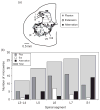Intraspinal microstimulation for the recovery of function following spinal cord injury
- PMID: 21867807
- PMCID: PMC3245977
- DOI: 10.1016/B978-0-444-53815-4.00004-2
Intraspinal microstimulation for the recovery of function following spinal cord injury
Abstract
Spinal cord injury is a devastating neurological trauma, often resulting in the impairment of bladder, bowel, and sexual function as well as the loss of voluntary control of muscles innervated by spinal cord segments below the lesion site. Research is ongoing into several classes of therapies to restore lost function. These include the encouragement of neural sparing and regeneration of the affected tissue, and the intervention with pharmacological and rehabilitative means to improve function. This review will focus on the application of electrical current in the spinal cord in order to reactivate extant circuitry which coordinates and controls smooth and skeletal muscle below the injury. We first present a brief historical review of intraspinal microstimulation (ISMS) focusing on its use for restoring bladder function after spinal cord injury as well as its utilization as a research tool for mapping spinal cord circuits that coordinate movements. We then present a review of our own results related to the use of ISMS for restoring standing and walking movements after spinal cord injury. We discuss the mechanisms of action of ISMS and how they relate to observed functional outcomes in animal models. These include the activation of fibers-in-passage which lead to the transsynaptic spread of activation through the spinal cord and the ability of ISMS to produce fatigue-resistant, weight-bearing movements. We present our thoughts on the clinical potential for ISMS with regard to implantation techniques, stability, and damage induced by mechanical and electrical factors. We conclude by suggesting improvements in materials and techniques that are needed in preparation for a clinical proof-of-principle and review our current attempts to achieve these.
Copyright © 2011 Elsevier B.V. All rights reserved.
Figures





References
-
- Aoyagi Y, Mushahwar VK, Stein RB, Prochazka A. Movements elicited by electrical stimulation of muscles, nerves, intermediate spinal cord, and spinal roots in anesthetized and decerebrate cats. IEEE Transactions on Neural Systems and Rehabilitation Engineering. 2004;12:1–11. - PubMed
-
- Barthelemy D, Leblond H, Rossignol S. Characteristics and mechanisms of locomotion induced by intraspinal microstimulation and dorsal root stimulation in spinal cats. Journal of Neurophysiology. 2007;97:1986–2000. - PubMed
Publication types
MeSH terms
Grants and funding
LinkOut - more resources
Full Text Sources
Medical

